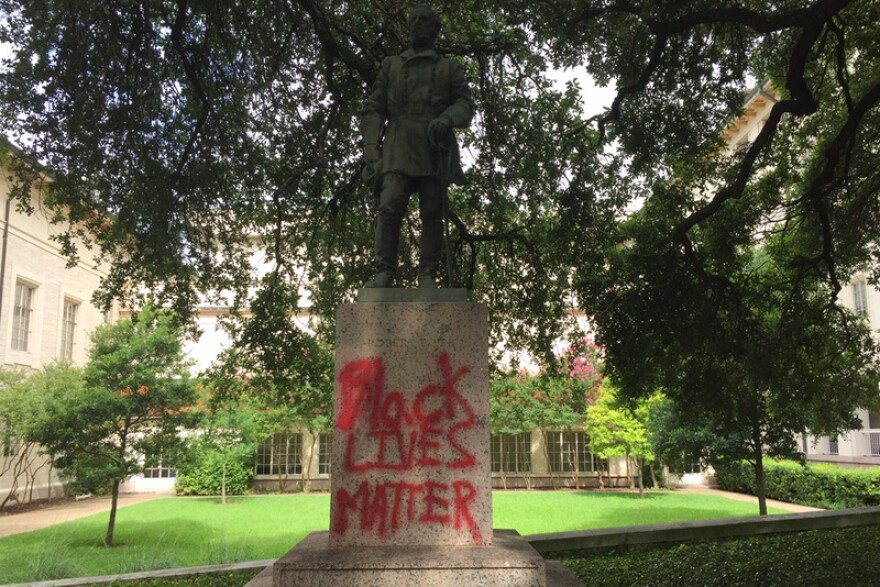The shooting at a historic black church in Charleston, South Carolina, last month spurred a nationwide debate over the Confederate flag. That state removed the flag that flew over its capitol, and retailers like Amazon and Walmart have stopped carrying the rebel flag.
The debate has extended to southern states, which are now grappling with what to do with Confederate memorials. And, in Texas, there are concerns about how new textbooks will teach the Civil War.
University of North Texas historian Richard Lowe explains Texas’ Confederate past.
What slavery looked like in Texas
“Along the Gulf coast, there were several counties where slavery was very highly developed with very large plantations producing cotton and sugar can,” Lowe says. “East Texas was also highly developed as far as slavery was concerned, but the holdings were not huge.”
In North Texas, slavery was not as developed. Lowe estimates there were about 1,100 slaves in Dallas County in 1860 – about 12 percent of the county’s population. They tended to be house servants or workers on small farms.
A last-ditch effort to save Texas
Lowe says it was “almost inevitable” that Texas would secede in 1861.
“As long as slavery existed in Texas, [it] was going to be part of that section of the nation that was nervous about slavery and nervous about its continuation,” he says.
However, Sam Houston, then the state’s governor, tried to stop secession from happening. When state delegates tried to get Houston to call a state meeting to consider secession, he refused and was kicked out of office.
In February 1861, Texas secessionist delegates issued its “declaration of causes” for leaving the Union:
Texas abandoned her separate national existence and consented to become one of the Confederated States to promote her welfare, insure domestic tranquility [sic] and secure more substantially the blessings of peace and liberty to her people. ... She was received as a commonwealth holding, maintaining and protecting the institution known as negro slavery--the servitude of the African to the white race within her limits--a relation that had existed from the first settlement of her wilderness by the white race, and which her people intended should exist in all future time. Her institutions and geographical position established the strongest ties between her and other slave-holding States of the confederacy. Those ties have been strengthened by association. But what has been the course of the government of the United States, and of the people and authorities of the non-slave-holding States, since our connection with them? The controlling majority of the Federal Government, under various pretences and disguises, has so administered the same as to exclude the citizens of the Southern States, unless under odious and unconstitutional restrictions, from all the immense territory owned in common by all the States on the Pacific Ocean, for the avowed purpose of acquiring sufficient power in the common government to use it as a means of destroying the institutions of Texas and her sister slave-holding States.
Read the full declaration from the Texas State Library and Archives Commission.
Texas was granted Confederate statehood in March 1861. As for Sam Houston, Lowe says he did not join either side of the war and eventually died before the Civil War’s end.
Though the Civil War ended in 1865, Texas did not rejoin the Union until five years later in 1870.
More on Texas Civil War history.
Texas after the Civil War
Lowe says race relations across the country was hugely shaped by what happened in the war and during the Reconstruction period.

“We’ve been struggling in Texas and the U.S. as a whole for 150 years trying to get that right,” Lowe says.
Texans can thank the Reconstruction efforts for the state’s public school system. Lowe says such a system didn’t exist before the Civil War.
“It was the Republicans in Reconstruction who established a public school system in Texas,” he says.
There’s now a debate in the Texas school system over the latest batch of history textbooks that will be released this fall. The books downplay slavery’s role in the Civil War. Lowe says that doesn’t fit with history.
“People who have studied this all their lives almost 100 percent agree … that without slavery, there would be no Civil War,” he says. “Occasionally, I get students who say it wasn’t about slavery, it was about state’s rights or the tariffs, and I always recommend that they read the statement of the Texas Secession convention. What they mention is slavery.”

Fights over Texas memorials, schools
Though the center of the Confederate flag debate has been in South Carolina, the debate over Confederate symbols has trickled into Texas. Here’s a round-up of some of the recent conflicts.
- The Dallas chapter of the NAACP has been looking into local memorials it wants to see removed. The Robert E. Lee statue at Oak Lawn Park was vandalized last week. A small group of protestors had gathered there two weeks earlier to hold an “un-dedication” ceremony.
'SHAME' written on Robert E. Lee statue at Lee Park in Dallas (PHOTOS: Clinton Kemp) RELATED: http://t.co/dhVm34tUhB pic.twitter.com/rwoxgqbmMq
— WFAA (@wfaa) July 10, 2015
- A statue of Confederate President Jefferson Davis was vandalized at UT-Austin last month. A petition signed by students and alumni called for the statue to be removed from campus. UT President Gregory Fenves formed a committee to review the Davis statue and other Confederate monuments on campus.

- A citizens group hopes to have a Confederate memorial relocated. Denton’s Confederate Soldiers Memorial is located about a block away from the Denton County Courthouse Square. The statue was placed on the Square in 1918 and has since been declared a Texas Historic Landmark, a National Historic Registry landmark and a Texas State Archeological Landmark. A petition to remove the statue was filed in 2008.
- On the flip side, calls from civil rights activist Reverend Kyev Tatum to change Richland High School’s Rebel mascot was met with pushback from students and parents. “It’s a cultural cleansing of the south is what it is,” Allen Hearrean told KTVT (CBS 11). “They are removing everything that relates to anything that’s southern. Pretty soon being a Texan will be racist.”
- A Confederate monument under construction in southeast Texas is generating controversy. The Beaumont Enterprise reports: "Despite community concerns about the city of Orange's image, motorists entering Texas from Louisiana on Interstate 10 will be greeted by 32 waving flags representing Texas regiments of the Confederate army as soon as the flagpoles are erected. The Confederate monument ... is nearing completion, despite earlier attempts to prevent construction. The free speech rights of Sons of Confederate Veterans trumps the disgust of many citizens."
- Commenter Patricia Carson Clarke points out: “The University of Texas at Arlington used to have the Rebels as a mascot. The Rebels were changed to the Mavericks in 1971. The students had voted to become Aardvarks.” When the Rebels were the school’s mascot, “Dixie became the unofficial fight song,” Gerald Saxon, a history professor at the school, told the Star-Telegram. “The whole issue of the Confederacy was ingrained in the school.” Past mascots for the school also included the Grubbworms, the Blue Riders, and now the Mavericks. Students voted to change the mascot’s name from Sam Maverick to Blaze the Maverick in 2007.
According to the Texas Tribune, there are 28 state public schools named after Confederate leaders Lee, Jefferson Davis, Stonewall Jackson and Albert Sidney Johnston.
Vocativ did a similar analysis nationwide and found at least 188 public charter schools were named after prominent Confederates. The two analyses did not look into lesser-known Confederate leaders.
Editor's note: UT Arlington once had a Confederate mascot until 1971. This post was updated to reflect that.








